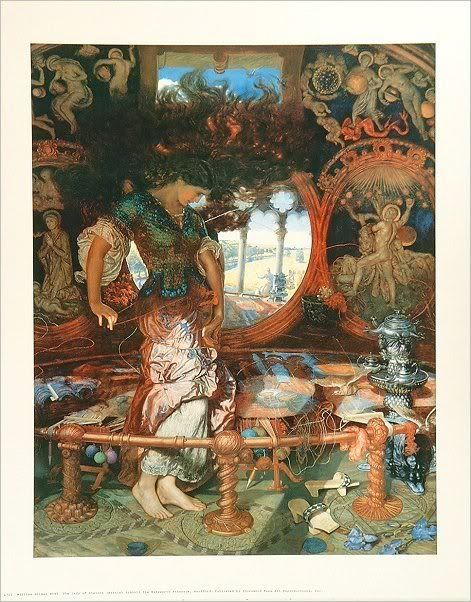
I have a belief, based on my own experience, that many fans of Pre-Raphaelite art are first drawn in by the story and paintings of the Lady of Shalott. Most people are familiar with Tennyson's beautiful poem, and the images of the Lady of Shalott are iconic. As Grace at The Beautiful Necessity noted a few days ago, images of the Lady of Shalott have inspired a host of artists, writers and musicians (most notably, in my view, Loreena McKennit's fabulous version).
Many of the Pre-Raphaelites painted the ill-fated lady, but today I have decided to include one of my favourite paintings of her from the period, one you may not have seen before.
This painting of the Lady of Shalott was first exhibited in 1905 and was the last (and in my opinion, best) of William Holman Hunt's works. It stands out in my mind for several reasons. First, it shows her at her loom, which I think is the most magical part of the story. Who can forget the first lines of the poem: "there she weaves by night and day a magic web of colours gay." Her wild hair and unraveled yarn foreshadow the disintigration of her life and add an air of drama to the picture that is less pronounced in most of the paintings of her. Plus, I love the wild look in her eye--it certainly seperates her from the majority of other paintings of the Lady of Shalott, most of which are more Ophelia-like (somewhat crazed, but resigned to their fate). Finally, the lady's face is very different from the visages found in William Holman Hunt's other paintings--it is far more lovely and looks as if it was inspired by the drawings of Edward Burne Jones.
The artist, William Holman Hunt is widely regarded today as one of the founding members of the Pre-Raphaelite Brotherhood. Like William de Morgan, he began his artistic training at the Royal Academy, but soon became weary of the conventions of Victorian art. After discovering the writings and art theory of John Ruskin he soon became a full-fledged member of the Pre-Raphaelite Brotherhood. His most famous work of art is The Awakening Conscience--a celebrated, and in my view, rather over-rated piece that demonstrates Hunt's devotion to artistic symbolism. Overall, he is definitely my least favourite of the Pre-Raphaelites. He had a hard time acheiving artistic success during his lifetime because both the press and the public found his works unattractive (a harsh blow for a Pre-Raphaelite artist who was supposed to be creating works of simple beauty). I confess that I'm not overly fond of the majority of his paintings, but I love this particular one.
William Holman Hunt's life was filled with scandal. After his first wife's death, he wanted to marry her sister, but this was illegal in England at the time so he was forced to travel abroad in order to marry her. This in turn caused a major rift within the Pre-Raphaelite Brotherhood, as another member artist, Thomas Woolner, was married to Aice Waugh, the third sister! (source: Wikipedia). To set the record straight, Hunt wrote an autobiographical account of the Brotherhood, entitled Pre-Raphaelitism and the Pre-Raphaelite Brotherhood, that placed special emphasis on his important role within the movement.
Today William Holman Hunt's Lady of Shalott hangs in the Manchester Art Gallery. 
Hunt's most famous work, the Awakening Consicence
Images courtesy Wikipedia Commons
Thursday, February 7, 2008
William Holman Hunt's Lady of Shalott
Posted by
Margaret
at
9:46 AM
![]()
![]()
Labels: pre-raphaelites, william morris
Subscribe to:
Post Comments (Atom)


3 comments:
The Lady of Shalott by Tennyson is one of my very favorites. This art is incredibly beautiful!
Nancy
When I have looked at this artwork, I was always struck by how her hair floating tumultuously around her echoed the tapestry she was weaving. The whole painting really successfully expresses a feeling of impending doom to me.
i only discovered 'the lady of shalott' today whilst researching an essay on holman hunt. i love it! there is something about her which is captivating and the whole image draws you in. beautiful!
Post a Comment